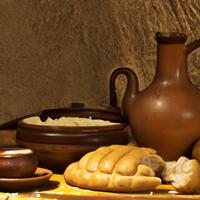
1 serving (43 grams) contains 120 calories, 4.0 grams of protein, 4.0 grams of fat, and 20.0 grams of carbohydrates.

Log this food in SnapCalorie

Nutrition Information
Calories |
666.7 | ||
|---|---|---|---|
% Daily Value* |
|||
| Total Fat | 22.2 g | 28% | |
| Saturated Fat | 11.1 g | 55% | |
| Polyunsaturated Fat | 0 g | ||
| Cholesterol | 55.6 mg | 18% | |
| Sodium | 1111.1 mg | 48% | |
| Total Carbohydrates | 111.1 g | 40% | |
| Dietary Fiber | 11.1 g | 39% | |
| Sugars | 11.1 g | ||
| protein | 22.2 g | 44% | |
| Vitamin D | 0 mcg | 0% | |
| Calcium | 222.2 mg | 17% | |
| Iron | 6.7 mg | 37% | |
| Potassium | 333.3 mg | 7% | |
* Percent Daily Values are based on a 2,000 calorie diet. Your daily values may be higher or lower depending on your calorie needs.
Food Attributes
Source of Calories
About Buttered wheat bread
Buttered wheat bread is a classic baked good combining the nutty, wholesome qualities of wheat flour with the rich, savory flavor of butter. Often associated with Western cuisine, it’s a staple in sandwiches, breakfast dishes, or simply enjoyed on its own. Whole wheat bread is prized for being higher in fiber, essential nutrients, and vitamins compared to white bread, making it a heartier option that supports digestive health and sustained energy. While the wheat base offers these benefits, the inclusion of butter adds saturated fats, and depending on the quantity, can increase the calorie count. Some versions use whole grains or reduced-fat butter to enhance its nutritional value. Its combination of taste and texture makes it a versatile, crowd-pleasing option, whether served toasted or fresh from the oven.



